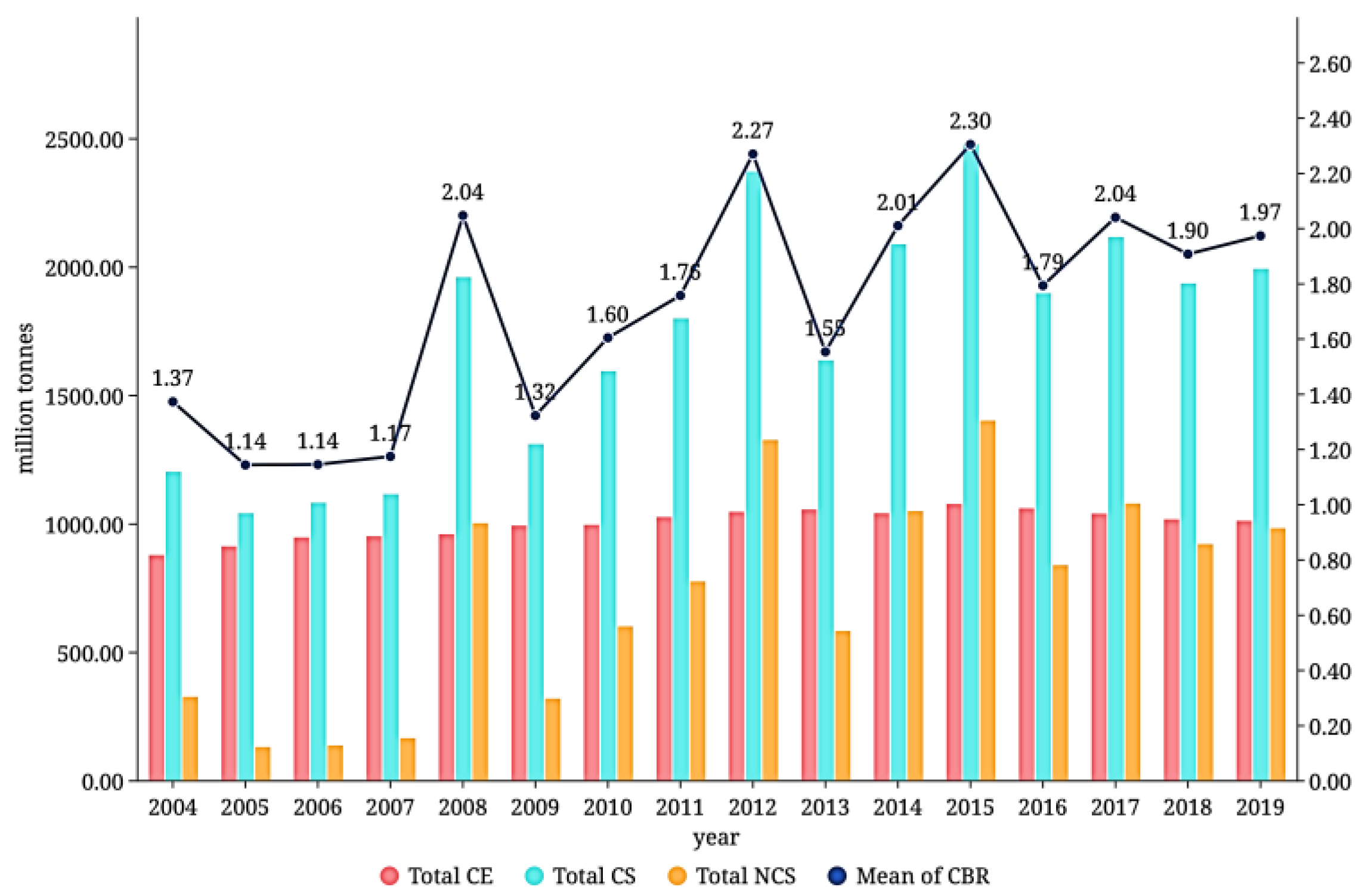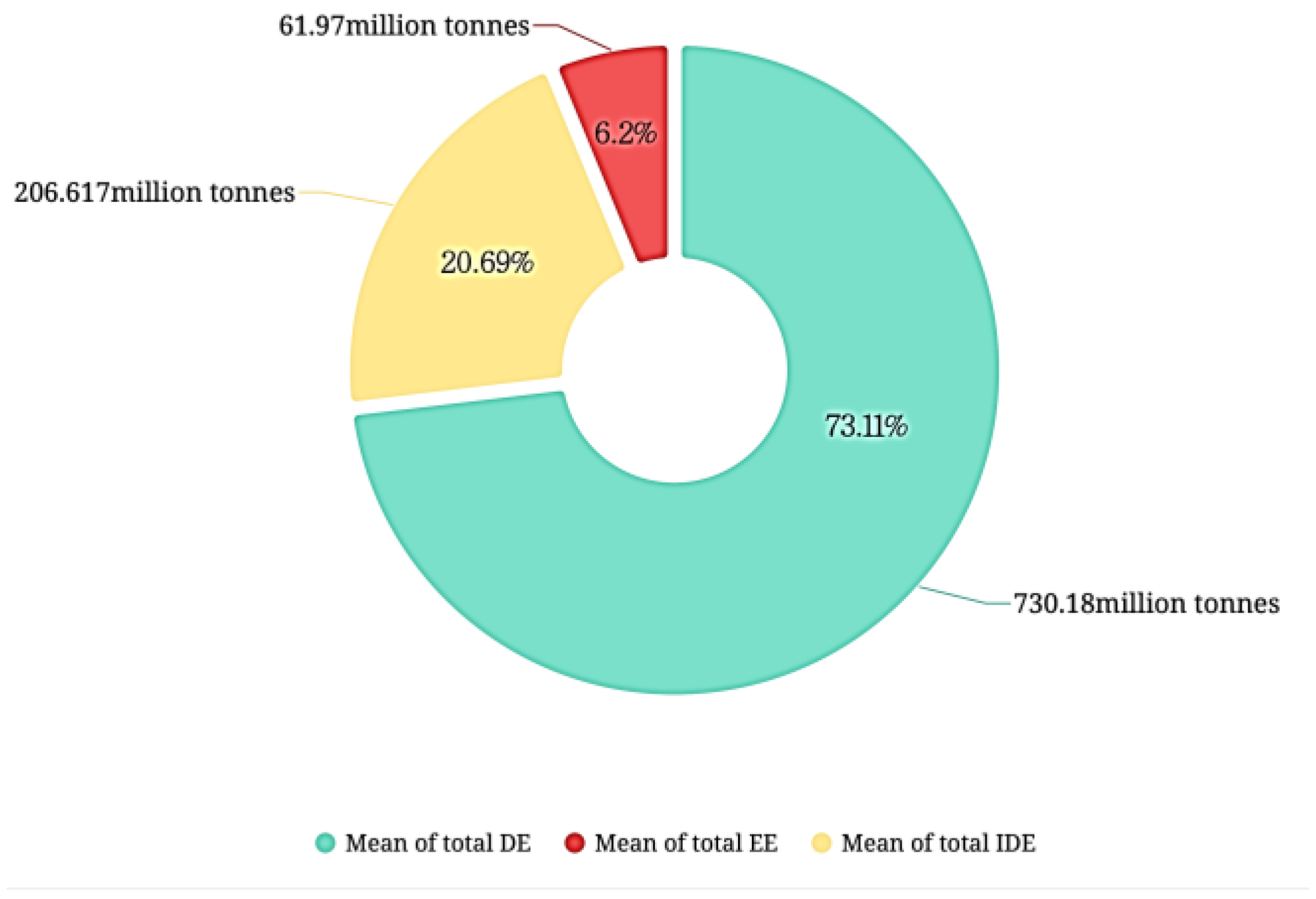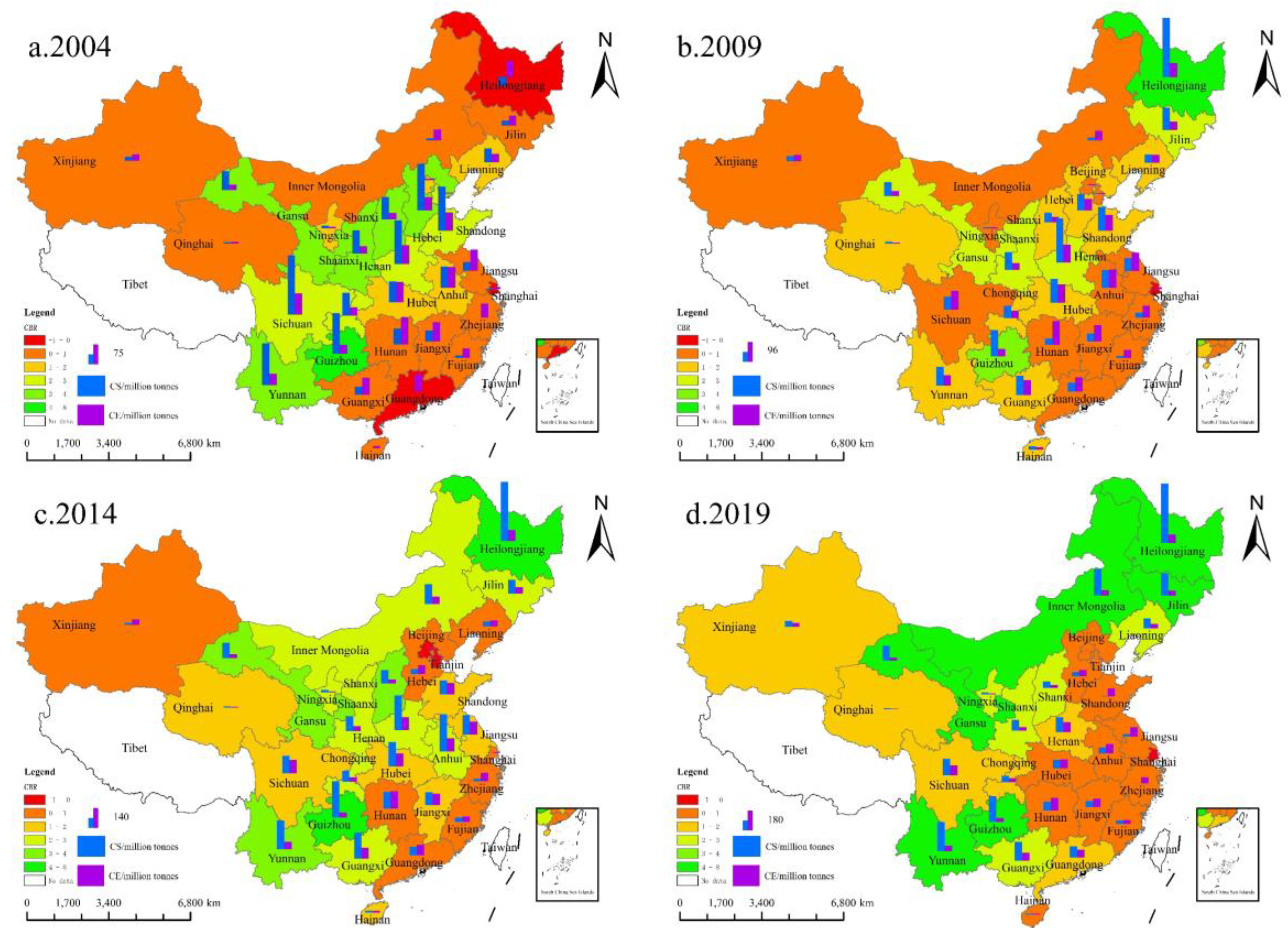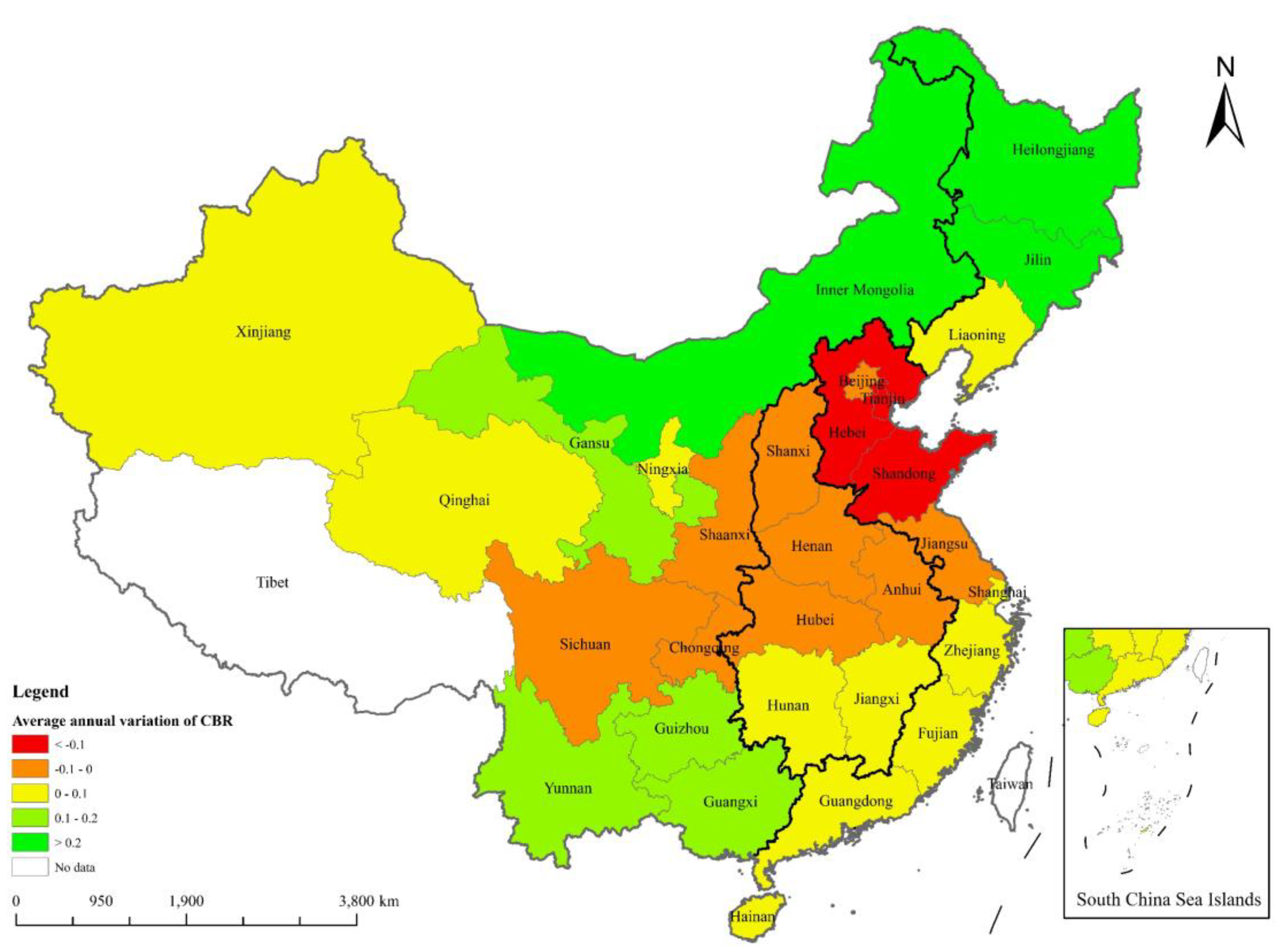Submitted:
19 April 2024
Posted:
22 April 2024
You are already at the latest version
Abstract
Keywords:
1. Introduction
2. Theoretical Mechanisms
2.1. Analysis of the Mechanisms Influencing the Land Management Scale
2.2. Analysis of Threshold Mechanisms
3. Materials and Methods
3.1. Variables
3.1.1. Indicator Selection
3.1.2. Data Sources
3.2. Modelling
4. Empirical Analyses
4.1. CBR Measure
4.2. Empirical Results
4.2.1. Spatial Spillover Effects
4.2.2. Threshold Characteristics
5. Further Discussion
5.1. Analysis of Spatial Heterogeneity
5.2. Threshold Value
6. Conclusion
Author Contributions
Funding
Institutional Review Board Statement
Informed Consent Statement
Data Availability Statement
Conflicts of Interest
References
- Lee, H.; Calvin, K.; Dasgupta, D.; Krinner, G.; Mukherji, A.; Thorne, P.; Trisos, C.; Romero, J.; Aldunce, P.; Barrett, K. Climate change 2023: synthesis report. Contribution of working groups I, II and III to the sixth assessment report of the intergovernmental panel on climate change; The Australian National University: Canberra, Australia, 2023. [Google Scholar]
- Rogelj, J.; Popp, A.; Calvin, K. V.; Luderer, G.; Emmerling, J.; Gernaat, D.; Fujimori, S.; Strefler, J.; Hasegawa, T.; Marangoni, G. Scenarios towards limiting global mean temperature increase below 1.5 C. Nature climate change 2018, 8, 325–332. [Google Scholar] [CrossRef]
- Keenan, T.F.; Williams, C.A. The terrestrial carbon sink. Annual Review of Environment and Resources 2018, 43, 219–243. [Google Scholar] [CrossRef]
- Lynch, J.; Cain, M.; Frame, D.; Pierrehumbert, R. Agriculture’s contribution to climate change and role in mitigation is distinct from predominantly fossil CO2-emitting sectors. Frontiers in sustainable food systems 2021, 4, 518039. [Google Scholar] [CrossRef] [PubMed]
- Zhao, M.; Shi, R.; Du, R.; Yao, L. The pathway to China’s carbon–neutral agriculture: Measures, potential and future strategies. Chinese Political Science Review 2023, 8, 304–324. [Google Scholar] [CrossRef]
- Johnson, J.M.F.; Franzluebbers, A.J.; Weyers, S.L.; Reicosky, D.C. Agricultural opportunities to mitigate greenhouse gas emissions. Environmental pollution 2007, 150, 107–124. [Google Scholar] [CrossRef] [PubMed]
- Tian, Y.; Zhang, J. Regional Differentiation Research on Net Carbon Effect of Agricultural Production in China. Journal of Natural Resources 2013, 28, 1298–1309. [Google Scholar]
- Chen, L.; Xue, L.; Xue, Y. Spatial Agglomeration and Variation of China’s Agricultural Net Carbon Sink. Ecology and Environmental Sciences 2015, 24, 1777–1784. [Google Scholar]
- Shang, J.; Yang, B. Estimation of Carbon Source and Carbon Sequestration in Planting Industry and Dynamic Analysis of Influencing Factors of Net Carbon Sequestration: A Case Study of Shandong Province. Reform 2019, 2019, 123–134. [Google Scholar]
- Li, B.; Wang, C.; Zhang, J. Dynamic evolution and spatial spillover of China’s agricultural net carbon sink. China Population, Resources and Environment 2019, 29, 68–76. [Google Scholar]
- Guan, J.; Zhang, S.; Ren, Y.; Sheng, C. Random forest model-assisted evaluation of spatiotemporal differentiation of China’s agricultural net carbon sink and evolution of influencing factors. China Environmental Science 2024, 44, 1158–1170. [Google Scholar]
- Wu, H.; Meng, Y.; Huang, H.; Chen, W. Spatiotemporal Coupling Between the Net Carbon Sequestration of Cropland Use and Agricultural Production in China. Journal of Soil and Water Conservation 2022, 36, 360-368+376. [Google Scholar]
- Lu, J.; Huang, X.; Dai, L.; Chen, Z.; Li, Y. Spatio-temporal Scale Analysis on the Equality of Energy Consumption Carbon Emission Distribution in China. Journal of Natural Resources. 2012, 27, 2006–2017. [Google Scholar]
- Du, J.; Luo, J.; Wang, R.; Wang, X. The Estimation and Analysis of Spatio-Temporal Change Patterns of Carbon Functions in Major Grain Producing Area. Journal of Ecology and Rural Environment 2019, 35, 1242–1251. [Google Scholar]
- Yang, Y.; Shi, Y.; Sun, W.; Chang, J.; Zhu, J.; Chen, L.; Wang, X.; Guo, Y.; Zhang, H.; Yu, L.; et al. Terrestrial carbon sinks in China and around the world and their contribution to carbon neutrality. Science China Life Sciences 2022, 65, 861–895. [Google Scholar] [CrossRef] [PubMed]
- Lund, P.J.; Hill, P.G. Farm size, efficiency and economies of size. Journal of Agricultural Economics 1979, 30, 145–158. [Google Scholar] [CrossRef]
- Luo, B.; Zhou, J.; Zang, H.; Sawut, A.; Feng, X.; Yang, Y.; Peixoto, L.; Wang, X.; Olesen, J.E.; Zeng, Z. Optimize farm size and agronomic practices to improve agricultural sustainability: a case of multi-indicator assessment from the North China Plain. Environment, Development and Sustainability 2023, 1–20. [Google Scholar] [CrossRef]
- Zhang, X. Study on Farm Size and Smallhoders Productivity in China; Chinese Academy of Agricultural Sciences, 2018. [Google Scholar]
- Xiao, X.; Li, Q. Agricultural production: accumulation of science and technology and the spatial spillover-a research based on the spatial panel data between 1986-2010. China Economic Studies 2013, 2013, 43–50. [Google Scholar]
- Gu, N.; Zhang, T. Financial Inclusion Development and Rural Poverty Reduction: Threshold, Spatial Spillover and Channel Effect. Journal of Agrotechnical Economics 2019, 74–91. [Google Scholar]
- Campi, M.; Duenas, M.; Fagiolo, G. How do countries specialize in agricultural production? A complex network analysis of the global agricultural product space. Environmental Research Letters 2020, 15, 124006. [Google Scholar] [CrossRef]
- Yao, H.; Zhao, X.; Gao, Q. Knowledge Flow and Spatial Interaction of Agricultural Science and Technologyamong Provinces in China. Science & Technology Progress and Policy 2021, 38, 34–42. [Google Scholar]
- Wang, Y.; Di, F.; Xin, L. The status and Problems of Grain Production in the Main Grain production Areas of China and Policy Suggestions. Research of Agricultural Modernization 2018, 39, 37–47. [Google Scholar] [CrossRef]
- Zhang, L.; Luo, B. Agricultural Reduction: the Logic of Scale in Agriculture and Its Evidence. Issues in Agricultural Economy 2020, 81–99. [Google Scholar]
- Wei, M.; Yan, T.; Luo, S. Impacts of Scale Operation and Technological Progress on Green and Low-carbon Development of Agriculture: a Quasi-natural Experiment Based on the Establishment of Major Grain-producing Areas. Issues in Agricultural Economy 2023, 41–65. [Google Scholar]
- Grossman, G.M.; Krueger, A.B. Environmental impacts of a North American free trade agreement. 1991. [Google Scholar]
- Grossman, G.M.; Krueger, A.B. Economic growth and the environment. The quarterly journal of economics 1995, 110, 353–377. [Google Scholar] [CrossRef]
- Schultz, T.W. Transforming traditional agriculture: Reply. Journal of farm Economics 1966, 48, 1015–1018. [Google Scholar] [CrossRef]
- Gu, B.; Duan, J.; Ren, C.; Wang, S.; Wang, C. Large-scale farming promotes agricultural green development in China. Journal of Agricultural Resources and Environment 2021, 38, 709–715. [Google Scholar]
- Drahmoune, F. Agrarian transitions, rural resistance and peasant politics in Southeast Asia. Journal of Current Southeast Asian Affairs 2013, 32, 111–139. [Google Scholar] [CrossRef]
- Liu, Q.; Xiao, H. What is the logic of the scale of farm management that affects agricultural carbon emissions? The mediating role of factor inputs and the moderating role of cultural quality. Rural Economy 2020, 10–17. [Google Scholar]
- Woodwell, G.M.; Whittaker, R.H.; Reiners, W.A.; Likens, G.E.; Delwiche, C.C.; Botkin, D.B. The Biota and the World Carbon Budget: The terrestrial biomass appears to be a net source of carbon dioxide for the atmosphere. Science 1978, 199, 141–146. [Google Scholar] [CrossRef]
- Hu, Y.; Zhang, K.; Hu, N.; Wu, L. Review on measurement of agricultural carbon emission in China. Chinese Journal of Eco-Agriculture 2023, 31, 163–176. [Google Scholar]
- IPCC. Climate change 2022: mitigation of climate change; Cambridge University Press: Cambridge, UK; New York, NY, USA, 2022. [Google Scholar]
- Fan, Z.; Song, C.; Qi, X.; Wu, F. Accounting of greenhouse gas emissions from China’s agricultural system in recent 40 years. Acta Ecologica Sinica 2022, 42, 9470–9482. [Google Scholar]
- Zhang, G.; Lu, F.; Huang, Z.; Chen, S.; Wang, X. Estimations of application dosage and greenhouse gas emission of chemical pesticides in staple crops in China. Chinese Journal of Applied Ecology 2016, 27, 2875–2883. [Google Scholar]
- Lal, R. Carbon emission from farm operations. Environment international 2004, 30, 981–990. [Google Scholar] [CrossRef] [PubMed]
- Feng, Z.; Liu, B.; Yang, Y. A Study of the Changing Trend of Chinese Cultivated Land Amount and Data Reconstructing: 1949-2003. Journal of Natural Resources 2005, 2005, 35–43. [Google Scholar]
- Bi, Y.; Zheng, Z. THE ACTUAL CHANGES OF CULTIVATED AREA SINCE THE FOUNDING OF NEW CHINA. Resources Science 2000, 2000, 8–12. [Google Scholar]
- Wang, Y.; Wang, B.; Ma, C.; Zhong, X.; Cai, Y. Study on the Multiple Cropping Index Based on Revised Cultivated Land Area in China. China Land Science 2008, 22, 46–52. [Google Scholar]
- Chen, Z.; Lu, M.; Jin, Y. Regional Differences of Human Capitals and Education Development in China: An Estimation of the Panel Data. The Journal of World Economy 2004, 2004, 25-31+77. [Google Scholar]
- Devendra, C.; Thomas, D. Smallholder farming systems in Asia. Agricultural systems 2002, 71, 17–25. [Google Scholar] [CrossRef]
- Zuo, L.; Zhang, Z.; Dong, T. Progress in the Research on the Multiple Cropping Index. Journal of Natural Resources 2009, 24, 553–560. [Google Scholar]
- Fan, J.; Wu, B. A Study on Cropping Index Potential Based on GIS. Journal of Remote Sensing 2004, 637–644. [Google Scholar]
- Li, Y.; Xue, C.; Chai, C.; Yao, S.; Li, W. Spatio-temporal variation and driving forces of net carbon sink of conservation tillage in China. China Population, Resources and Environment 2022, 32, 15–23. [Google Scholar]
- He, Q.; Ju, W.; Dai, S.; He, W.; Song, L.; Wang, S.; Mao, G. Drought risk of global terrestrial gross primary productivity over the last 40 years detected by a remote sensing-driven process model. Journal of Geophysical Research: Biogeosciences 2021, 126, e2020JG005944. [Google Scholar] [CrossRef]
- Muntean, M.; Janssens-Maenhout, G.; Song, S.; Giang, A.; Selin, E.N.; Zhong, H.; Zhao, Y.; Olivier, J.G.J.; Guizzardi, D.; Crippa, M.; et al. Evaluating EDGARv4.tox2 speciated mercury emissions ex-post scenarios and their impacts on modelled global and regional wet deposition patterns. Atmospheric Environment 2018, 184, 56–68. [Google Scholar] [CrossRef]
- Shan, Y.; Guan, D.; Zheng, H.; Ou, J.; Li, Y.; Meng, J.; Mi, Z.; Liu, Z.; Zhang, Q. China CO2 emission accounts 1997-2015. Scientific data 2018, 5, 1–14. [Google Scholar] [CrossRef] [PubMed]
- Elhorst, J.P. Spatial panel data models. Spatial econometrics: From cross-sectional data to spatial panels 2014, 37–93. [Google Scholar]
- Hansen, B.E. Threshold effects in non-dynamic panels: Estimation, testing, and inference. Journal of econometrics 1999, 93, 345–368. [Google Scholar] [CrossRef]
- Li, H.; Fu, L.; Huang, Z.; Peng, W. Various forms of moderate-scale management of agriculture and development prospects. Acta Agriculturae Zhejiangensis 2021, 33, 161–169. [Google Scholar]
- Ye, B. Status Quo and Countermeasures for Green Development of Zhejiang Agriculture. Journal of Zhejiang Agricultural Sciences 2022, 63, 1434–1436. [Google Scholar]
- Luo, L.; Fan, L. Spatial Characteristics of Income-Enhancing Effects of Rural Human Capital in China. Journal of Management World 2014, 2014, 58–76. [Google Scholar]
- Meng, F.; Tan, Y.; Chen, H.; Xiong, W. Spatial-temporal Evolution Patterns and Influencing Factors of “Non-grain” Utilization of Cultivated Land in China. China Land Science 2022, 36, 97–106. [Google Scholar]
- Zhou, Q. Analysis of Factors Affecting Farmers’ Willingness to Grow Food. Journal of Agrotechnical Economics 2009, 2009, 25–30. [Google Scholar]
- He, X. Reflections on the scale of land management in agriculture in China. Issues in Agricultural Economy 2016, 37, 4–15. [Google Scholar]
- Yu, Y.; Huang, Y.; Zhang, W. Projected changes in soil organic carbon stocks of China’s croplands under different agricultural managements, 2011–2050. Agriculture, ecosystems & environment 2013, 178, 109–120. [Google Scholar]
- Liu, F. A Study of the Conditions of the Scale Operation of Farmland, and of the Effect thereof: Taking the Northeastern Countryside as a Case. Journal of Management World 2006, 2006, 71-79,171-172. [Google Scholar]




| Carbon emissions source | Emission factor | Data source |
|---|---|---|
| Nitrogen fertilizer production, transportation and use | 1.53 kg(CO2)·kg−1 | [35] |
| Phosphate fertilizer production, transportation and use | 1.63 kg(CO2)·kg−1 | [35] |
| Potassium fertilizer production, transportation and use | 0.65 kg(CO2)·kg−1 | [35] |
| Compound fertilizer production, transportation and use | 1.77 kg(CO2)·kg−1 | [35] |
| Pesticide production, transportation and use | 4.9341 kg(C)·kg−1 | [36] |
| Agricultural plastic film production, transportation and use | 5.18 kg(C)·kg−1 | [37] |
| Gas | AR6-GWP100 | Lifetime |
|---|---|---|
| CO2 | 1 | N/A |
| CH4 | 27 | 11.8 |
| N2O | 273 | 109 |
| Variables | Unit | Observations | Mean | Standard deviation | Min | Max |
|---|---|---|---|---|---|---|
| SCALE | hectare·person-1 | 480 | 0.701 | 0.578 | 0.192 | 3.524 |
| INCOME | yuan | 480 | 9975 | 5450 | 2638 | 33195 |
| EDU | year | 480 | 8.421 | 0.877 | 5.368 | 11.50 |
| SA | 1000 hectares | 480 | 5371 | 3643 | 88.60 | 14783 |
| UCE | kg·hectare-1 | 480 | 5130 | 1016 | 2870 | 8169 |
| UCA | kg·hectare-1 | 480 | 7702 | 5899 | 1159 | 33608 |
| LI | 480 | 0.646 | 0.144 | 0.343 | 0.982 | |
| SR | 480 | 0.191 | 0.164 | 0 | 0.680 | |
| TEM | °C | 480 | 13.93 | 5.328 | 2.549 | 25.43 |
| SUN | hour | 480 | 2047 | 485.9 | 933.0 | 2960 |
| PRE | mm | 480 | 953.1 | 447.3 | 200.8 | 2232 |
| year | CBR | lnSCALE | ||||
|---|---|---|---|---|---|---|
| Moran’s I | Z value | P value | Moran’s I | Z value | P value | |
| 2004 | 0.4273 | 3.6710 | 0.0002 | 0.6973 | 5.9634 | 0.0000 |
| 2005 | 0.4051 | 3.5236 | 0.0004 | 0.7039 | 6.0274 | 0.0000 |
| 2006 | 0.2966 | 2.6500 | 0.0080 | 0.7082 | 6.0796 | 0.0000 |
| 2007 | 0.3998 | 3.5533 | 0.0004 | 0.7015 | 6.0500 | 0.0000 |
| 2008 | 0.3277 | 2.9128 | 0.0036 | 0.7293 | 6.2985 | 0.0000 |
| 2009 | 0.1313 | 1.3591 | 0.1741 | 0.7132 | 6.1818 | 0.0000 |
| 2010 | 0.3557 | 3.2597 | 0.0011 | 0.7070 | 6.1350 | 0.0000 |
| 2011 | 0.3219 | 2.9218 | 0.0035 | 0.7017 | 6.0893 | 0.0000 |
| 2012 | 0.3571 | 3.2271 | 0.0013 | 0.7052 | 6.1379 | 0.0000 |
| 2013 | 0.4528 | 3.8892 | 0.0001 | 0.6886 | 5.9876 | 0.0000 |
| 2014 | 0.2827 | 2.6566 | 0.0079 | 0.6722 | 5.8556 | 0.0000 |
| 2015 | 0.2426 | 2.3379 | 0.0194 | 0.6539 | 5.7066 | 0.0000 |
| 2016 | 0.2970 | 2.7253 | 0.0064 | 0.6472 | 5.6286 | 0.0000 |
| 2017 | 0.3545 | 3.3022 | 0.0010 | 0.6305 | 5.4774 | 0.0000 |
| 2018 | 0.4103 | 3.6126 | 0.0003 | 0.6249 | 5.4032 | 0.0000 |
| 2019 | 0.4953 | 4.3207 | 0.0000 | 0.6182 | 5.3276 | 0.0000 |
| Variables | (1) OLS | (2) FE | (3) SAR | (4) SEM | (5) SDM |
|---|---|---|---|---|---|
| CBR | CBR | CBR | CBR | CBR | |
| lnSCALE | 0.773** | 1.495** | 1.447** | 1.213* | 1.345** |
| (2.23) | (2.22) | (2.06) | (1.76) | (2.05) | |
| lnINCOME | 0.436 | -2.370* | -1.115*** | -0.873** | -3.108** |
| (1.18) | (-1.76) | (-3.71) | (-2.46) | (-2.39) | |
| lnEDU | -2.002 | 4.581 | 4.140* | 4.820* | 4.996** |
| (-1.08) | (1.62) | (1.92) | (1.94) | (2.06) | |
| lnSA | 0.399*** | 2.462** | 1.423* | 1.248 | 1.308 |
| (4.43) | (2.62) | (1.70) | (1.38) | (1.57) | |
| lnUCE | -3.118*** | 5.075*** | 4.575*** | 4.358*** | 4.051*** |
| (-3.03) | (3.81) | (3.58) | (2.85) | (3.29) | |
| lnUCA | 0.596** | -0.734 | -0.438 | -0.281 | -0.249 |
| (2.53) | (-1.61) | (-1.14) | (-0.68) | (-0.70) | |
| LI | -3.426** | -3.924** | -3.366*** | -3.748*** | -2.785* |
| (-2.32) | (-2.29) | (-2.83) | (-2.72) | (-1.69) | |
| SR | 1.834 | 1.456 | 0.290 | 0.441 | 1.129 |
| (1.20) | (1.29) | (0.35) | (0.49) | (1.52) | |
| lnPRE | -0.232 | 2.287*** | 1.277*** | 1.980*** | 2.279*** |
| (-0.67) | (4.26) | (3.90) | (4.10) | (3.53) | |
| lnTEM | -0.599 | -2.572*** | -1.545** | -1.801** | -2.333*** |
| (-1.18) | (-2.82) | (-2.37) | (-2.27) | (-2.99) | |
| lnSUN | -2.628** | -1.228 | -1.355*** | -2.427** | -2.036* |
| (-2.28) | (-1.44) | (-2.58) | (-2.46) | (-1.80) | |
| Constant | 43.618*** | -42.929** | |||
| (2.85) | (-2.15) | ||||
| ρ | 0.469*** | 0.467*** | |||
| (8.03) | (8.56) | ||||
| σ | 0.540*** | ||||
| (9.83) | |||||
| Observations | 480 | 480 | 480 | 480 | 480 |
| R2 | 0.433 | 0.470 | 0.406 | 0.389 | 0.497 |
| ID FE | YES | YES | YES | YES | |
| YEAR FE | YES |
| Variables | Wx | Direct effect | Indirect effect | Total effect |
|---|---|---|---|---|
| lnSCALE | 1.676* | 1.693** | 4.058** | 5.750*** |
| (1.76) | (2.35) | (2.44) | (2.77) | |
| lnINCOME | 2.156 | -3.062*** | 1.253 | -1.810*** |
| (1.50) | (-2.65) | (0.90) | (-2.92) | |
| lnEDU | -4.924 | 4.918** | -4.562 | 0.356 |
| (-1.47) | (2.20) | (-0.94) | (0.07) | |
| lnSA | 1.213 | 1.575* | 3.139** | 4.714*** |
| (1.18) | (1.95) | (2.05) | (2.58) | |
| lnUCE | 0.057 | 4.317*** | 3.332 | 7.649*** |
| (0.03) | (3.85) | (1.43) | (3.21) | |
| lnUCA | -0.791 | -0.368 | -1.587 | -1.955 |
| (-0.90) | (-1.15) | (-1.24) | (-1.54) | |
| LI | 0.634 | -2.947* | -1.185 | -4.131 |
| (0.32) | (-1.86) | (-0.43) | (-1.43) | |
| SR | 1.911 | 1.426* | 4.171 | 5.598* |
| (1.29) | (1.85) | (1.63) | (1.91) | |
| lnPRE | -1.811** | 2.228*** | -1.363* | 0.865* |
| (-2.48) | (3.87) | (-1.70) | (1.79) | |
| lnTEM | 0.859 | -2.375*** | -0.477 | -2.852* |
| (0.77) | (-3.18) | (-0.31) | (-1.96) | |
| lnSUN | 2.049 | -1.901* | 1.917 | 0.016 |
| (1.42) | (-1.92) | (1.18) | (0.02) |
| Variables | Main | Wx |
|---|---|---|
| lnSCALE | 1.964*** | 7.584*** |
| (2.89) | (4.39) | |
| lnINCOME | -3.107** | 0.622 |
| (-2.42) | (0.45) | |
| lnEDU | 3.134 | -9.833 |
| (1.25) | (-1.17) | |
| lnSA | 2.237** | 5.422** |
| (2.56) | (2.57) | |
| lnUCE | 5.402*** | 2.117 |
| (4.56) | (0.51) | |
| lnUCA | -0.472 | -1.268 |
| (-1.17) | (-1.16) | |
| LI | -2.964* | 4.061 |
| (-1.85) | (0.85) | |
| SR | 1.861* | 11.958*** |
| (1.74) | (2.68) | |
| lnPRE | 2.060*** | -1.895** |
| (3.59) | (-2.17) | |
| lnTEM | -2.748*** | 5.054** |
| (-2.77) | (2.48) | |
| lnSUN | -1.436* | 1.862 |
| (-1.65) | (1.15) |
| Variables | (1) | (2) | (3) | (4) |
|---|---|---|---|---|
| CBR | CE | UCS | lnSA | |
| lnSCALE | 1.780*** | -1.136 | 3.536*** | 0.101** |
| (4.38) | (-1.20) | (5.21) | (2.41) | |
| lnINCOME (lnscale≤δ1) | -1.116*** | 4.733*** | -1.171*** | -0.017 |
| (-5.03) | (6.59) | (-3.32) | (-0.75) | |
| lnINCOME (δ1<lnscale≤δ2) | 1.259** | 2.414*** | -1.513*** | 0.334*** |
| (2.36) | (4.84) | (-3.19) | (8.91) | |
| lnEDU (lnscale≤δ1) | 5.665*** | -13.309*** | 5.953** | 0.056 |
| (3.64) | (-3.29) | (2.42) | (0.34) | |
| lnEDU (δ1<lnscale≤δ2) | -3.927* | -2.853 | 6.676** | -1.526*** |
| (-1.66) | (-0.85) | (2.51) | (-8.09) | |
| lnSA | 1.534*** | 7.821*** | 0.089 | |
| (3.56) | (8.72) | (0.13) | ||
| lnUCE | 4.632*** | 7.658*** | 8.562*** | -0.360*** |
| (6.75) | (5.60) | (8.53) | (-5.15) | |
| lnUCA | -0.647*** | 0.007 | -0.877*** | 0.066*** |
| (-2.95) | (0.02) | (-2.61) | (2.91) | |
| LI | -3.775** | 0.664 | -2.722 | 1.323*** |
| (-2.54) | (0.21) | (-1.18) | (9.31) | |
| SR | 1.210 | 1.109 | 3.952** | 0.139 |
| (1.15) | (0.49) | (2.42) | (1.28) | |
| lnPRE | 1.550*** | -0.754 | 2.580*** | 0.024 |
| (4.47) | (-1.00) | (4.79) | (0.67) | |
| lnTEM | -3.534*** | -2.233 | -4.363*** | 0.037 |
| (-5.12) | (-1.49) | (-4.05) | (0.52) | |
| lnSUN | -1.742*** | -4.378*** | -3.654*** | 0.060 |
| (-2.60) | (-3.01) | (-3.51) | (0.87) | |
| Constant | -33.918*** | -68.352*** | -41.320*** | 10.080*** |
| (-3.69) | (-3.55) | (-2.89) | (11.99) | |
| Observations | 480 | 480 | 480 | 480 |
| R2 | 0.469 | 0.599 | 0.455 | 0.369 |
| Threshold evaluation | 0.594** | -1.033 | -0.564*** | 0.007** |
| (37.90) | (41.59) | (42.64) | (121.24) |
| Variables | (1) SDM | (2) SDM_GA |
|---|---|---|
| CBR | CBR | |
| lnSCALE | 1.345** | 1.409 |
| (2.05) | (1.52) | |
| nlnSCALE | 10.833*** | |
| (4.35) | ||
| elnSCALE | -1.938* | |
| (-1.90) | ||
| wlnSCALE | 1.822 | |
| (1.05) | ||
| ρ | 0.467*** | 0.444*** |
| (8.56) | (8.22) | |
| Observations | 480 | 480 |
| R2 | 0.497 | 0.560 |
| ID FE | YES | YES |
Disclaimer/Publisher’s Note: The statements, opinions and data contained in all publications are solely those of the individual author(s) and contributor(s) and not of MDPI and/or the editor(s). MDPI and/or the editor(s) disclaim responsibility for any injury to people or property resulting from any ideas, methods, instructions or products referred to in the content. |
© 2024 by the authors. Licensee MDPI, Basel, Switzerland. This article is an open access article distributed under the terms and conditions of the Creative Commons Attribution (CC BY) license (http://creativecommons.org/licenses/by/4.0/).




